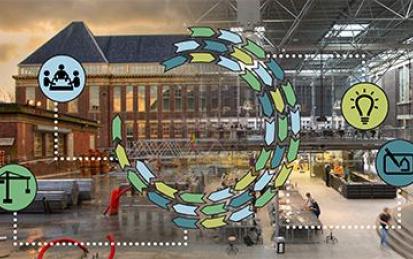

Our Courses

Managing Building Adaptation: A Sustainable Approach
Learn how to adapt buildings sustainably by applying management tools to real-life cases in the built environment.
-
Course by

-
 Self Paced
Self Paced
-
 30
30
-
 English
English

Built environment sustainability assessment
The course introduces the basic elements and trends for performing a through built environment assessment and develops the tools for urban sustainability policy impact analysis.
-
Course by

-
 Self Paced
Self Paced
-
 11
11
-
 English
English

Healthier Materials and Sustainable Building
In the Healthier Materials and Sustainable Building specialization, you learn about healthier building materials, exploring subjects ranging from classification of toxic chemicals to new green innovations. You start by investigating the intersection of building materials and human health. Then, you learn how chemistry and toxicology affect the built world. Next, you examine design specifications from a healthier materials perspective. Finally, you employ cutting-edge practices to execute a healthier materials project, from design to construction to the use phase.
-
Course by

-
 Self Paced
Self Paced
-
 English
English

"Making" Progress Teach-Out
What is “progress”? How do we decide when we’re moving forward and not taking steps backward? And how do we explore the idea of progress around public sites of memory? This Teach-Out is an invitation to think about what progress means, and how you can look for it wherever you are—in your city, community, or neighborhood—and reflect upon your own ideas about the place you live in. Changes in the built environment of our communities are themselves the result of human actions and intentions, such as municipal planning, commercial enterprises, or communities transforming their own space.
-
Course by

-
 Self Paced
Self Paced
-
 6 hours
6 hours
-
 English
English

Material Chemistry and Sustainable Building
This course covers a wide range of concepts related to toxicology and the chemistry of healthier materials. You learn about toxic substances in the built environment, the impact of specific chemicals on human health, unsatisfactory substitutions, and barriers to change. Finally, you examine ways to remove chemicals of concern in common building products. This course is designed to give you a basic understanding of chemistry in the built environment.
-
Course by

-
 Self Paced
Self Paced
-
 12 hours
12 hours
-
 English
English

Geodesign: Change Your World
Ignite your career with Geodesign! The magnitude of challenges before us exceeds the reach of conventional approaches to planning and design. The pandemic has spawned urgent needs for new design approaches and solutions. Also at the doorstep is climate change: altering community design approaches; addressing infrastructure types and locations; as well as the need to protect carbon-sequestering environs. Geodesign provides a revolutionary way forward.
-
Course by

-
 Self Paced
Self Paced
-
 11 hours
11 hours
-
 English
English

Act on Climate: Steps to Individual, Community, and Political Action
Are you concerned about climate change? Would you like to learn how to address and respond to this challenge? If so, this course is for you. Act on Climate: Steps to Individual, Community, and Political Action is intended to help learners understand, address and respond to climate change as individuals and in partnership with their communities and political leaders. The course focuses on how to translate learning into action on climate change in the areas of food, energy, transportation and the built environment (cities).
-
Course by

-
 Self Paced
Self Paced
-
 25 hours
25 hours
-
 English
English

Sustainable Construction in a Circular Economy
This course takes a wide-lens view of the role of materials decisions in circular design and the promotion of a healthier world. You find out how to execute a healthier project. You learn why healthier materials matter to the entire project team and the importance of communication between teams. You look at circularity, embodied carbon reduction, and the evolution of the built environment. You examine the role designers play in executing a healthier project, from construction to installation to use, and its significance in the context of cities.
-
Course by

-
 Self Paced
Self Paced
-
 25 hours
25 hours
-
 English
English

Environmental Hazards and Global Public Health
The second course of the Impacts of the Environment on Global Public Health specialization will explore a number of different environmental hazards. These are: air pollution, water pollution, solid and hazardous waste, and two physical hazards (radon and noise). These hazards each have the potential to harm human health, and we will explore how you may come into contact with these hazards and how they may harm you, as well as what we can do to minimize these exposures and health impacts.
-
Course by

-
 Self Paced
Self Paced
-
 17 hours
17 hours
-
 English
English

Data science perspectives on pandemic management
The COVID-19 pandemic is one of the first world-wide scenarios where data made a difference in capturing and analyzing the diffusion and impact of the disease. We offer an introductory course for decision makers, policy makers, public bodies, NGOs, and private organizations about methods, tools, and experiences on the use of data for managing current and future pandemic scenarios. This course describes modern methods for data-driven policy making in the context of pandemics.
-
Course by

-
 Self Paced
Self Paced
-
 10 hours
10 hours
-
 English
English



